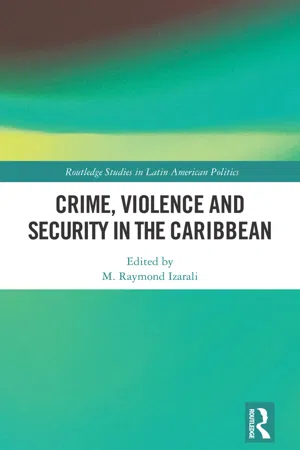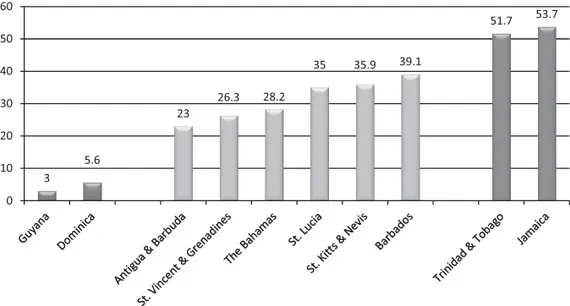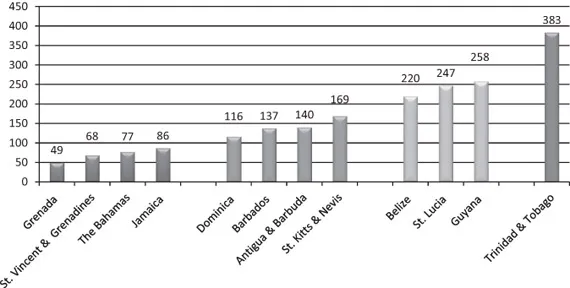![]()
Part 1
Crime, Violence and Punishment
![]()
1 Crime, Violence, and Public Safety in the Caribbean
Randy Seepersad
Introduction
Caribbean countries are only just beginning to develop a willingness to publish crime data. In the past, many countries did not release such data to the public, whether because of political insecurity, because it would hurt their image as ideal tourist destinations, or because of other reasons. Policy makers and security experts in many countries have recognized the importance of utilizing such data to inform policy development and have partnered with academic institutions and other relevant experts to assist with the analysis of such data. One of the factors which has driven this process is the increasing crime rates in Caribbean countries. This, along with the need for increasing transparency and accountability, has resulted in greater levels of openness in terms of sharing crime data.
Despite the above, many Caribbean countries continue to have serious limitations with regard to the systematic collection of crime data and have only just begun to explore some of the ways that such data can be used. In most Caribbean countries police reports are still manually recorded and tallied. Computerized data collection systems do not exist in some countries and there are serious delays between the collection and collation of crime statistics. Some countries such as Jamaica and Trinidad and Tobago, in contrast, have begun to utilize computerized data collection systems which can collate crime statistics in real time. In the case of Trinidad and Tobago, crime data are now geo-coded and can be used in conjunction with other geo-coded datasets to do complex spatial analyses of crime patterns and to examine the spatial correlates of crime. In the case of Jamaica, the Ministry of National Security has begun to utilize multivariate analyses with its victimization survey data. Despite these advances, Caribbean crime data are notoriously difficult to source since in many cases data are not available in electronic format and must be collected in paper-based formats and collated to provide overall national statistics. In other cases there are no specific points of contact for the supply of such data and data must be sourced from several sources within each country. Many countries also continue to exhibit reluctance to sharing crime data with the public and with academic institutions.
This chapter will examine official crime data as well as victimization survey data from the Caribbean. Official data are for the period 2000 to 2010 and include data on murders, shootings, robberies, rape, and burglaries and break-ins for several Caribbean countries.1 Comparisons are restricted to these crimes since the definitions are similar across the countries which are examined. Victimization survey data from the UNDP (2012) Caribbean Human Development Report on Citizen Security will also be examined. This includes victimization survey data from a random sample of 11,207 respondents in seven Caribbean countries. Both datasets will be utilized to make comparisons of the victimization rates of official crime data versus victimization survey data to estimate the proportion of crimes that are not reported to the police. The chapter will also examine possible causal factors which may be useful in explaining crime in the Caribbean. Regression models for the Caribbean as a whole and for each of the seven countries in the UNDP (2012) dataset will be computed and assessed. The chapter will explore the policy recommendations which derive from the assessment of causal factors.
Official Crime Data
Table 1.1 shows the number of murders in Caribbean countries from 2000 to 2010. During this period Jamaica had an average of 1,349 murders per annum, followed by Trinidad and Tobago with an average of 328. Guyana had an annual average of 133 murders, while Belize had an annual average of 86. The countries with the lowest averages were Dominica with an average of seven murders per annum and Grenada and Antigua and Barbuda, each with an average of 10. The sharpest increases in the number of murders occurred in Jamaica and Trinidad and Tobago. For the period from 2000 to 2010, the number of murders in Jamaica increased by an average of 54.1 per annum while in Trinidad and Tobago the number increased by 35.3 per annum. The only other countries with notable increases were Belize with an average annual increase of 8.5 and Guyana with an increase of 6.5 per year. Countries with negligible increases were St. Vincent and the Grenadines and Antigua and Barbuda. The only country with a decrease in the average annual number of murders for the period under consideration was Grenada.
Murder rates allow for a comparison of the risk of victimization in different countries. While the number of murders may be comparatively small in many Caribbean countries, very small population sizes may mean that the risk of victimization may be comparatively large. For the period under consideration, the highest murder rates occurred in Jamaica (with a rate of 51.7 murders per 100,000 inhabitants), Belize (35.8), St. Kitts and Nevis (29.2) and Trinidad and Tobago (26). It is typically the case that Jamaica and Trinidad and Tobago are singled out for their high murder rates and large number of murders, although the rates in Belize and St. Kitts and Nevis indicate that the risk of becoming a victim of murder is also comparably high. Figure 1.1 graphs the annual average murder rates for Caribbean countries for the period 2000 to 2010. The countries can be grouped based on similarity in murder rates. Jamaica stands on its own, while Belize, St. Kitts and Nevis, and Trinidad and Tobago are grouped as the countries with the second highest murder rates. Guyana, St. Vincent and the Grenadines, the Bahamas, and St. Lucia are in the third group and have annual average murder rates which range between 17.8 and 21.5. The countries with the lowest murder rates are Barbados, Grenada, Dominica, and Antigua and Barbuda, which all have annual average rates below 13 murders per 100,000 inhabitants. The average murder rate for the Caribbean as a whole2 increased steadily from 2000 to 2008 and then remained at a rate of approximately 28 per 100,000 from 2008 to 2010 (see Figure 1.2). In 2000 the average murder rate for the Caribbean stood at 14.4 murders per 100,000 inhabitants. In 2008 the rate stood at 28.6 per 100,000 inhabitants.
Table 1.1 Official Homicide Statistics for Selected Caribbean Nations (2000—10)
Figure 1.1 Average Homicide Rates for Selected Caribbean Nations (2000–10)
Statistics for shootings in Caribbean countries for the period 2000 to 2010 are shown in Table 1.2. The largest number of shootings occurred in Jamaica, with an average of 1,401 shootings per annum, and Trinidad and Tobago with an average of 653 per annum. Barbados had the third highest average at 105 shootings per annum. All other countries had less than one hundred shootings per annum. The countries with the most rapid increases in shootings were Jamaica and Trinidad and Tobago. In Jamaica the number of shootings increased by an average of 48.5 per year during the 2000 to 2010 period, while in Trinidad and Tobago the number increased by 23.6 per year. In Trinidad and Tobago the sharpest increase occurred from 2000 to 2003. From 2003 to 2008 there was stability in the number of shootings, and after 2008 there was a gradual decline until available data in 2010. In Jamaica, in contrast, there was a steady increase in the number of shootings for the period under consideration. The only other country with a notable increase in the number of shootings was the Bahamas in which the number of incidents increased by an average of 11.5 shootings per year. Other countries had negligible increases in the number of shootings, with decreases occurring in Barbados and Guyana.
Figure 1.2 Average Homicide Rate for the Caribbean (2000–10)
The highest shooting rates occurred in Jamaica and Trinidad and Tobago (see Figure 1.3). From 2000 to 2010 Jamaica had an average of 53.7 shootings per 100,000 inhabitants while Trinidad and Tobago had an average of 51.7. The next highest rate occurred in Barbados (with a rate of 39.1 shootings per 100,000 inhabitants), St. Kitts and Nevis (35.9), St. Lucia (35), the Bahamas (28.2), St. Vincent and the Grenadines (26.3) and Antigua (23). The countries with the lowest shooting rates in the Caribbean were Dominica (5.6) and Guyana (3). When the Caribbean as a whole is considered, the average shooting rate has increased from 2000 to 2010 (Figure 1.4). In 2000 the rate stood at 24.9 shootings per 100,000 inhabitants. The rates increased from 2000 to 2004. In the latter year the rate stood at 32.9 shootings per 100,000 inhabitants. From 2004 to 2006 there was a decrease in the average shooting rate. The rate, however, increased from 27.1 in 2006 to 44.4 in 2010.
Table 1.3 provides robbery statistics for Caribbean countries for the period 2000 to 2010. The largest number of robberies occurred in Jamaica, with an annual average of 4,832, and Trinidad and Tobago, with an annual average of 2,239. Guyana also had a notable number of robberies with an annual average of 1,939. This was followed by Belize (529), St. Lucia (388), Barbados (368), the Bahamas (235), and Antigua and Barbuda (108). All other countries had less than 100 robberies per annum. The countries with the most rapid increases in the number of robberies were Trinidad and Tobago, Guyana, and Jamaica. In Trinidad and Tobago, the number of robberies increased by an average of 98.1 incidents per year from 2000 to 2010. In Guyana robberies increased by an average of 96.3 incidents per year, while in Jamaica robberies increased by an average of 51.9 incidents per year. Robbery trends in Trinidad and Tobago show a fluctuating but clear increase from 2000 to 2010. In Jamaica there was a very gradual decline in robberies from 2000 to 2007 but then a sharp increase after 2007. The increase subsequent to 2007 was sufficiently strong to offset any gains in the previously noted decline. In Guyana there was a sharp increase in the number of robberies from 2000 to 2002, followed by a decline to 2003. Subsequent to 2003 there was a consistent increase in the annual number of robberies. A number of countries had negligible increases in the number of robberies, with an increase of less than ten robberies per year. These include Barbados, Grenada, St. Lucia, St. Vincent and the Grenadines, St. Kitts and Nevis, Dominica, and Antigua and Barbuda. With an average decline of 16 incidents per year, Belize was the only country with a decrease in the annual number of robberies.
Table 1.2 Official Shooting Statistics for Selected Caribbean Nations (2000–10)
Figure 1.3 Average Shooting Rates for Selected Caribbean Nations (2000–10)
Figure 1.4 Average Shooting Rate for the Caribbean (2000–2010)
Table 1.3 Official Robbery Statistics for Selected Caribbean Nations (2000–10)
The highest robbery rate in the Caribbean occurred in Trinidad and Tobago, which had an average annual rate of 383 robberies per 100,000 inhabitants (Figure 1.5). This was followed by Guyana (258), St. Lucia (247), and Belize (220). Countries with more moderate rates were St. Kitts and Nevis (169), Antigua and Barbuda (140), Barbados (137), and Dominica (116). The countries with the lowest robbery rates were Jamaica (86), the Bahamas (77), St. Vincent and the Grenadines (68), and Grenada (49).
Table 1.4 shows the number of reported rapes in Caribbean countries for the period from 2000 to 2010. The countries with the highest average annual number of rapes were Jamaica, with an average of 806 incidents per annum, and Trinidad and Tobago, with an average of 279 incidents. The Bahamas and Guyana also had a notable number of rapes, with annual averages of 117 and 114 incidents, respectively. The only country with a notable increase in the annual number of rapes was the Bahamas. Here the number of rapes increased by an average of 10.4 incidents per year from 2000 to 2010. In the Bahamas the number of rapes increased from 101 in 2000 to 140 in 2002. There was a decline in the number of rapes from 2002 to 2006. In the latter year 72 rapes were reported. Subsequent to 2006 the number of rapes increased rapidly, by an average of 33.3 incidents per year. In contrast, eight of the countries listed in Table 1.4 exhibited decreases in the annual number of rapes, while one country (St. Kitts and Nevis) had no change in the number of rapes. The most pronounced decreases occurred in Jamaica, with an average decline by 16.6 rapes per annum, and Guyana, with an average decline by 6.1 rapes per annum.
Figure 1.5 Average Robbery Rates for Selected Caribbean Na...








